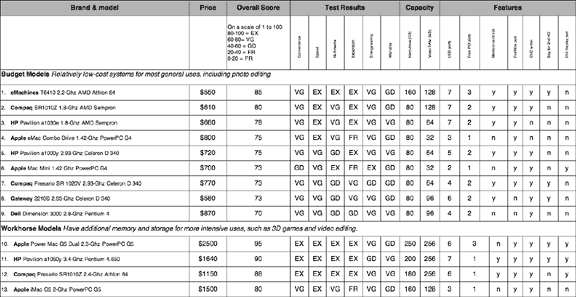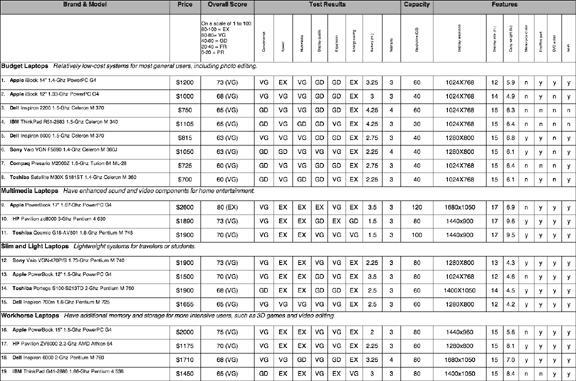Many Low End Mac readers have responded to last
week's article on how badly Consumer Reports (CR)
handles Macintosh computers in their holiday gift buying guide.
There has been a lot of agreement and affirmation, and it's great
to see that the word is getting out about the shortcomings of CR's
ratings.
A few readers mentioned that they hoped for CR-style ratings
charts in my article, but they were disappointed not to find them.
I considered including charts with the original article, but I
decided not to because I didn't have access to the data for all of
the machines I wanted to include.
On further consideration (and after discussion with the editors
at Low End Mac), I decided to follow-up with some Consumer
Reports-style ratings charts that compare Apple's machines
appropriately and fairly.
These charts show how CR could have compared Apple's computers
with Windows PCs. They were created by the author, adpted from CR's
data, and are provided as an example only and are not intended to
replace CR's copyrighted material.
Disclaimer: The original CR data used to generate the charts
below (on pages 36 & 37 of the December 2005 issue, Vol. 70 No.
12) only included a total of three Macintosh desktop computers and
two Macintosh laptops. Thus, the four additional Macintosh machines
shown below include ratings data that is approximated and
not a product of CR's testing (or any other formal
testing).
If you read the first article, you'll know that I had two
primary complaints about the CR ratings charts. First, they
segregated the Macs into a Macintosh "ghetto" so that
point-by-point comparison was difficult or impossible. Second, they
included a minimal number of Macintosh systems, in the process
suggesting that the Apple line either didn't have machines that
would fit into their categories or inferring that one system or
another was worse than it purports to be.
Here, then, is my version of a good Desktop System ratings
chart. Notice that I have added one of the Power Mac G5 systems to
the "workhorse" category. (Click on the these charts to see the
full-sized originals.)
Ranking Key:
- EX = excellent
- VG = very good
- GD = good
- FR = fair
- PR = poor
Notes in the ratings:
Systems are ranked by their overall scores. The best that I can
tell is that these are determined by the test results; therefore,
the score and test results for the Power Mac G5 system (line 10)
are approximated using the system specs and a comparison to the
non-Macintosh machines on the chart.
USB ports listed do not include the two USB 1.1 ports available
on Apple keyboards, which are supplied with all Macintosh systems
listed except the Mac mini.
Warranty presents an interesting rating when it comes to the
Apple machines, since CR ranks the Apple warranty as "Good" while
they consistently give Apple very high marks for customer service
and support.
Price is approximated for the system only, with the exception of
the iMac and eMac, which both include built-in displays. Please
note that the price for the Mac mini has been adjusted from CR's
approximation, since they added in $78 for mouse and keyboard,
which are not a part of the "system only" described.
Likewise, here is an adjusted version of the Laptop Computers
ratings chart. This time you'll notice that I've added three
additional Macintosh 'Books into the mix.
Ranking key is the same for both charts.
Notes on the ratings:
Again, systems are ranked by their overall scores. As with the
desktops, I approximated results for the additional included
machines: the 12" iBook (line 2), the 17" PowerBook (line 9), and
the 12" PowerBook (line 13). This time, however, my approximations
were based on comparisons to other non-Macintosh machines and to
the Macs that were ranked.
Note also that the listings (taken from CR) show an older model
for the 15" PowerBook, which now has a better screen resolution for
the same price. (I'll grant that this is likely the case for many
of the systems listed because of CR's lead time.)
As you can see, when placed side-by-side, the Macintosh systems
hold their own and, in many cases, rise to the top for performance,
features, and overall ranking. Consumer Reports truly ought to
develop a more comprehensive and fair cross-platform rating system,
especially given the rising popularity of the Macintosh
platform.
If all other considerations are truly equal, CR should give
consumers a clear picture of how Macs compare to their Windows PC
counterparts.
One more conclusion that I arrived at through this exercise: CPU
speed is fairly useless for determining the functionality of a
machine. I know that Apple proponents (and Apple spokespeople) have
been claiming this for years, but a close look at these charts
shows it demonstrably. Anytime you can have 3 GHz, 1.8 GHz,
and 1.67 GHz machines all performing equally with something as
taxing as multimedia (see "Multimedia Laptops"), you know there is
a disparity. This is not just a difference from one chip maker to
another, either - notice the number of variations made by Intel but
ranked approximately the same for speed and performance. Chip speed
is truly no longer a predictor of performance.
Once again, I hope this is helpful in guiding your holiday
shopping. Shop smart! 




